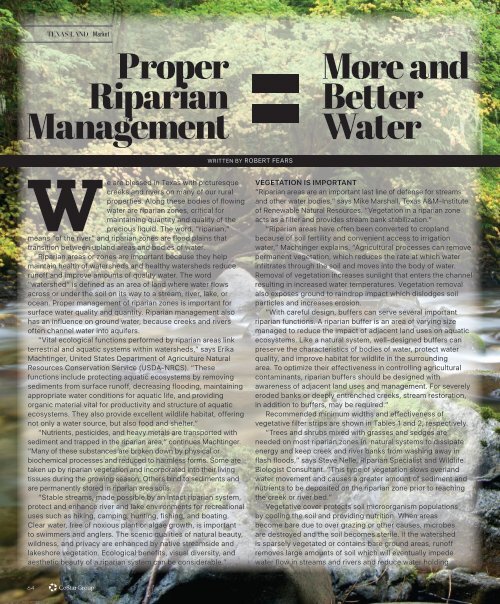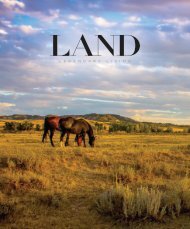Create successful ePaper yourself
Turn your PDF publications into a flip-book with our unique Google optimized e-Paper software.
TEXAS LAND / Market<br />
Proper<br />
Riparian<br />
Management<br />
More and<br />
Better<br />
Water<br />
e are blessed in Texas with picturesque<br />
creeks and rivers on many of our rural<br />
properties. Along these bodies of flowing<br />
water are riparian zones, critical for<br />
maintaining quantity and quality of the<br />
precious liquid. The word, “riparian,”<br />
means “of the river” and riparian zones are flood plains that<br />
transition between upland areas and bodies of water.<br />
Riparian areas or zones are important because they help<br />
maintain health of watersheds and healthy watersheds reduce<br />
runoff and improve amounts of quality water. The word<br />
“watershed” is defined as an area of land where water flows<br />
across or under the soil on its way to a stream, river, lake, or<br />
ocean. Proper management of riparian zones is important for<br />
surface water quality and quantity. Riparian management also<br />
has an influence on ground water, because creeks and rivers<br />
often channel water into aquifers.<br />
“Vital ecological functions performed by riparian areas link<br />
terrestrial and aquatic systems within watersheds,” says Erika<br />
Machtinger, United States Department of Agriculture Natural<br />
Resources Conservation Service (USDA-NRCS). “These<br />
functions include protecting aquatic ecosystems by removing<br />
sediments from surface runoff, decreasing flooding, maintaining<br />
appropriate water conditions for aquatic life, and providing<br />
organic material vital for productivity and structure of aquatic<br />
ecosystems. They also provide excellent wildlife habitat, offering<br />
not only a water source, but also food and shelter.”<br />
“Nutrients, pesticides, and heavy metals are transported with<br />
sediment and trapped in the riparian area,” continues Machtinger.<br />
“Many of these substances are broken down by physical or<br />
biochemical processes and reduced to harmless forms. Some are<br />
taken up by riparian vegetation and incorporated into their living<br />
tissues during the growing season. Others bind to sediments and<br />
are permanently stored in riparian area soils.<br />
“Stable streams, made possible by an intact riparian system,<br />
protect and enhance river and lake environments for recreational<br />
uses such as hiking, camping, hunting, fishing, and boating.<br />
Clear water, free of noxious plant or algae growth, is important<br />
to swimmers and anglers. The scenic qualities of natural beauty,<br />
wildness, and privacy are enhanced by native streamside and<br />
lakeshore vegetation. Ecological benefits, visual diversity, and<br />
aesthetic beauty of a riparian system can be considerable.”<br />
VEGETATION IS IMPORTANT<br />
“Riparian areas are an important last line of defense for streams<br />
and other water bodies,” says Mike Marshall, Texas A&M-Institute<br />
of Renewable Natural Resources. “Vegetation in a riparian zone<br />
acts as a filter and provides stream bank stabilization.”<br />
“Riparian areas have often been converted to cropland<br />
because of soil fertility and convenient access to irrigation<br />
water,” Machtinger explains. “Agricultural processes can remove<br />
permanent vegetation, which reduces the rate at which water<br />
infiltrates through the soil and moves into the body of water.<br />
Removal of vegetation increases sunlight that enters the channel<br />
resulting in increased water temperatures. Vegetation removal<br />
also exposes ground to raindrop impact which dislodges soil<br />
particles and increases erosion.<br />
“With careful design, buffers can serve several important<br />
riparian functions. A riparian buffer is an area of varying size<br />
managed to reduce the impact of adjacent land uses on aquatic<br />
ecosystems. Like a natural system, well-designed buffers can<br />
preserve the characteristics of bodies of water, protect water<br />
quality, and improve habitat for wildlife in the surrounding<br />
area. To optimize their effectiveness in controlling agricultural<br />
contaminants, riparian buffers should be designed with<br />
awareness of adjacent land uses and management. For severely<br />
eroded banks or deeply entrenched creeks, stream restoration,<br />
in addition to buffers, may be required.”<br />
Recommended minimum widths and effectiveness of<br />
vegetative filter strips are shown in Tables 1 and 2, respectively.<br />
“Trees and shrubs mixed with grasses and sedges are<br />
needed on most riparian zones in natural systems to dissipate<br />
energy and keep creek and river banks from washing away in<br />
flash floods,” says Steve Nelle, Riparian Specialist and Wildlife<br />
Biologist Consultant. “This type of vegetation slows overland<br />
water movement and causes a greater amount of sediment and<br />
nutrients to be deposited on the riparian zone prior to reaching<br />
the creek or river bed.”<br />
Vegetative cover protects soil microorganism populations<br />
by cooling the soil and providing nutrition. When areas<br />
become bare due to over grazing or other causes, microbes<br />
are destroyed and the soil becomes sterile. If the watershed<br />
is sparsely vegetated or contains bare ground areas, runoff<br />
removes large amounts of soil which will eventually impede<br />
water flow in streams and rivers and reduce water holding<br />
64

















